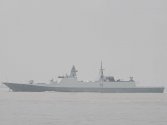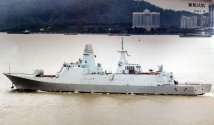We just saw these smaller missiles you described on both the Thunderer and the experimental corvette, so maybe they will accompany frigates in the future.What I still don't get is why they haven't opted to include several different types of VLS on ships like the 055 to enable the fitting of a bunch more cells like many other navies do. I.e. a portion are the largest CCL UVLS that can accomodate the YJ-21 and the other largest missiles, and the rest are some smaller version that can hold a more slender selection of missiles (but not the HQ-16 VLS). Or even a mix of 3 types. You're not going to allocate all tubes to hold the largest missile anyway so having them all be that large seems like an inefficiency.
You are using an out of date browser. It may not display this or other websites correctly.
You should upgrade or use an alternative browser.
You should upgrade or use an alternative browser.
054B/new generation frigate
- Thread starter Blitzo
- Start date
What I still don't get is why they haven't opted to include several different types of VLS on ships like the 055 to enable the fitting of a bunch more cells like many other navies do. I.e. a portion are the largest CCL UVLS that can accomodate the YJ-21 and the other largest missiles, and the rest are some smaller version that can hold a more slender selection of missiles (but not the HQ-16 VLS). Or even a mix of 3 types. You're not going to allocate all tubes to hold the largest missile anyway so having them all be that large seems like an inefficiency.
You said those bolded sentences - But I would say that those 850mm UVLS can actually be made to multi-pack smaller missiles (RIM-162-like MRSAMs, for instance). In fact, we do know that the PLAN is actually looking into multipacking capability for their 850mm UVLS cells in recent years.
Besides, there is always the potentials for smaller missiles to grow bigger following further development and iteration processes. Why even cut off those growth routes with smaller VLS cells just for the sake of being able to have more VLS cells - And solely for that specific time period?
Using varying different diameters of VLS cells for just one warship would also repeating the same mistakes that the Soviet surface combatants had. That is, literally handicapping one of the very advantages of having a universal-diameter VLS design, i.e. flexible missile loadout capability. With 3 or more types/sizes of VLS cells on a single warship, that's pretty much impossible to achieve.
Moreover, for ship designers, there is more than just VLS cell diameters to consider - Namely the cell depth. No matter how big or how small the diameter of the cells are, the length of the VLS cells are also constrained by what's located underneath the cells in their respective sections of the warship.
Furthermore, doing so would be unnecessarily (over)complicate the designing, manufacturing, logistics and maintenance. Imagine the workloads required to deal with three or more seperate systems of VLS, all on just one warship. Then multiply that across the entire fleet.
Last edited:
lcloo
Major
If you have UVLS why opt for two or three types of VLS of different diameters? A single cell of UVLS can hold several smaller missiles, it can hold 2, 3 or 4 smaller missiles.What I still don't get is why they haven't opted to include several different types of VLS on ships like the 055 to enable the fitting of a bunch more cells like many other navies do. I.e. a portion are the largest CCL UVLS that can accomodate the YJ-21 and the other largest missiles, and the rest are some smaller version that can hold a more slender selection of missiles (but not the HQ-16 VLS). Or even a mix of 3 types. You're not going to allocate all tubes to hold the largest missile anyway so having them all be that large seems like an inefficiency.
UVLS is flexible in that for different missions it can hold different mix of missiles like anti-air, anti-surface and ASW missile carried torpedoes. Smaller VLS usually can only be used for missiles of certain types only.
The purpose of UVLS is to eliminate having different types of VLS on a ship.
You said those bolded sentences - But I would say that those 850mm UVLS can actually be made to multi-pack smaller missiles (RIM-162-like MRSAMs, for instance). In fact, we do know that the PLAN is actually looking into multipacking capability for their 850mm UVLS cells in recent years.
Besides, there are always the potentials for smaller missiles to grow bigger following further development and iteration processes. Why even cut off those growth routes with smaller VLS cells just for the sake of being able to have more VLS cells - And solely for that specific time period?
Using varying different diameters of VLS cells for just one warship would also repeating the same mistakes that the Soviet surface combatants had. That is, literally handicapping one of the very advantages of having a universal-diameter VLS design, i.e. flexible missile loadout capability. With 3 or more types/sizes of VLS cells on a single warship, that's pretty much impossible to achieve.
Moreover, for ship designers, there is more than just VLS cell diameters to consider - Namely the cell depth. No matter how big or how small the diameter of the cells are, the length of the VLS cells are also constrained by what's located underneath the cells in their respective sections of the warship.
Furthermore, doing so would be unnecessarily (over)complicate the designing, manufacturing, logistics and maintenance. Imagine the workloads required to deal with three or more seperate systems of VLS, all on just one warship. Then multiply that across the entire fleet.
Correction. Also, continuing from the above:
If there is an actual need for more than one size of VLS cells onboard, then it must only be of two different sizes, at most - And the newly-added/included VLS cells must be noticably larger than the presently-available VLS cells onboard the warship.
TBH, I don't really mind having a somewhat smaller, ship-launched variant of the DF-17 that can snipe USN warships from 3000+ kilometers away. This would require LVLS cells with significantly larger diameter (~1100-1200mm) and a deeper cell depth (~11-12 meters), which is theoretically achievable by placing the LVLS cells higher up in the hull and superstructure.
(The aft VLS cells on the Burke DDGs, which are placed at the roof level of their helicopter hangars should be a feasible reference material for such future adventures.)
Similarly, these individual LVLS cells should also be capable of multipacking those missiles which can only be singularly-carried by the 850mm UVLS cells. That is, given a largely similar footprint and using the exact same missile model, it would be very much preferable that the LVLS is able to carry more of it than the UVLS.
In fact, these points are literally the only reasons why anyone with UVLS technology would ever consider having warships with VLS cells of more than one size installed onboard these days.
Last edited:
Can't unsee it now, the main gun literally looks like a p*nis head
Please, change it to something cool looking like on the FREMMs
It's the fashion these days. Have you seen JMSDF Mogami class?Can't unsee it now, the main gun literally looks like a p*nis head
Please, change it to something cool looking like on the FREMMs


